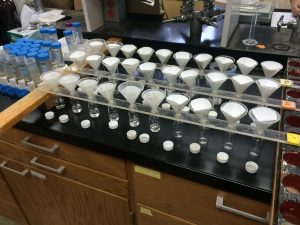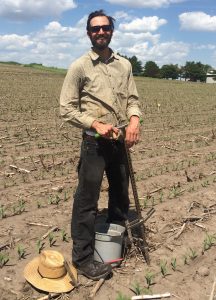Greg Richardson supports Discovery Farms’ work on soil health as part of his master’s degree research. He is currently completing a joint degree in Soil Science and Agroecology at the University of Wisconsin-Madison and will graduate in 2018.
UW Discovery Farms is excited to be performing a soil health survey as a part of its Nitrogen Use Efficiency project. We are evaluating the influence of soil properties (e.g. soil organic matter) and farm management practices (e.g. planting cover crops) on biological measures of soil health. This research, which began in 2015 and will wrap up this year, is the first study of its kind in Wisconsin.
The Discovery Farms soil health team has selected three main tests that represent biological activity or important carbon and nitrogen pools in the soil. The results will therefore reflect the natural ability of a soil to provide nutrients to crops, the microbial activity of the soil, or in some cases, both. The three tests – potentially mineralizable nitrogen (PMN), potentially mineralizable carbon (PMC), and permanganate oxidizable carbon (POXC) – were chosen because they have been shown to be effective in other studies, they are relatively affordable, and are already offered by some soil testing labs in the United States.


Using standardized laboratory methods, we will compare the results across farm systems to evaluate which biological measures of soil health are most sensitive to differences in specific management practices (e.g. manure application, tillage, and cover crop use). In addition, we will evaluate how closely these soil health measures are connected with commonly used soil measures like pH and soil organic matter.
At this time, Discovery Farms has completed soil tests on all of the 2015 and 2016 soil samples and the 2017 samples are being processed. Preliminary results indicate that across all farms tillage practices, use of manure, and/or seeding of cover crops do not have a clear effect on the soil health test results. An example of this is shown in Figure 1, for results of permanganate oxidizable carbon (POXC).

The lack of clear trends is not surprising for two reasons. The first is that there are many variables to consider aside from management that influence the outcome of soil health measurements, when taking averages across all farms. For example, the texture, pH, and the previous year’s weather can influence carbon and nitrogen cycling. The next round of statistics will involve advanced regression techniques to pull out which effects (management and soil properties) most influence each soil measure. The second reason is that changes to soil properties can take years to decades to become noticeable. The Discovery Farms team is currently acquiring historic farm management data from participating farmers to better account for this.
Final results will be synthesized in the coming months and we look forward to sharing what we’ve learned in 2018.
This article originally appeared in the latest UW Discovery Farms newsletter. If you would like to read more from the newsletter please click here.
- Soil health research update - November 20, 2017
